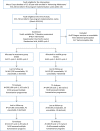Insecurity, distress and mental health: experimental and randomized controlled trials of a psychosocial intervention for youth affected by the Syrian crisis
- PMID: 28967980
- PMCID: PMC5972454
- DOI: 10.1111/jcpp.12832
Insecurity, distress and mental health: experimental and randomized controlled trials of a psychosocial intervention for youth affected by the Syrian crisis
Abstract
Background: Strengthening the evidence base for humanitarian interventions that provide psychosocial support to war-affected youth is a key priority. We tested the impacts of an 8-week programme of structured activities informed by a profound stress attunement (PSA) framework (Advancing Adolescents), delivered in group-format to 12-18 year-olds in communities heavily affected by the Syrian crisis. We included both Syrian refugee and Jordanian youth.
Methods: We followed an experimental design, comparing treatment youth and wait-list controls over two programme implementation cycles, randomizing to study arm in cycle 2 (ClinicalTrials.gov ID: NCT03012451). We measured insecurity, distress, mental health difficulties, prosocial behaviour and post-traumatic stress symptoms at three time-points: baseline (n = 817 youth; 55% Syrian, 43% female), postintervention (n = 463; 54% Syrian, 47% female), and follow-up (n = 212, 58% Syrian, 43% female). Regression models assessed: prospective intervention impacts, adjusting for baseline scores, trauma exposure, age, and gender; differential impacts across levels of trauma exposure and activity-based modality; and sustained recovery 1 year later. We analysed cycle-specific and cycle-pooled data for youth exclusively engaged in Advancing Adolescents and for the intent-to-treat sample.
Results: We found medium to small effect sizes for all psychosocial outcomes, namely Human Insecurity (β = -7.04 (95% CI: -10.90, -3.17), Cohen's d = -0.4), Human Distress (β = -5.78 (-9.02, -2.54), d = -0.3), and Perceived Stress (β = -1.92 (-3.05, -0.79), d = -0.3); and two secondary mental health outcomes (AYMH: β = -3.35 (-4.68, -2.02), d = -0.4; SDQ: β = -1.46 (-2.42, -0.50), d = -0.2). We found no programme impacts for prosocial behaviour or post-traumatic stress reactions. Beneficial impacts were stronger for youth with exposure to four trauma events or more. While symptoms alleviated for both intervention and control groups over time, there were sustained effects of the intervention on Human Insecurity.
Conclusions: Findings strengthen the evidence base for mental health and psychosocial programming for a generation affected by conflict and forced displacement. We discuss implications for programme implementation and evaluation research.
Keywords: Mental health and psychosocial support; evaluation; forced displacement; implementation science; refugees; war.
© 2017 The Authors. Journal of Child Psychology and Psychiatry published by John Wiley & Sons Ltd on behalf of Association for Child and Adolescent Mental Health.
Figures


Comment in
-
Commentary: Advancing an implementation science agenda on mental health and psychosocial responses in war-affected settings: comment on trials of a psychosocial intervention for youth affected by the Syrian crisis - by Panter-Brick et al. (2018).J Child Psychol Psychiatry. 2018 May;59(5):542-544. doi: 10.1111/jcpp.12870. J Child Psychol Psychiatry. 2018. PMID: 29667736
References
-
- Ager, A. , Ager, W. , Stavrou, V. , & Boothby, N. (2011). Inter‐agency guide for the evaluation of psychosocial programming in humanitarian crises. New York: UNICEF.
-
- Ager, A. , Burnham, G. , Checchi, F. , Gayer, M. , Grais, R. , Henkens, M. , … & Spiegel, P. (2014). Strengthening the evidence base for health programming in humanitarian crises. Science, 345, 1290–1292. - PubMed
-
- Ager, A. , & Metzler, J. (2017). Where there is no intervention: Insights into processes of resilience supporting war‐affected children. Peace and Conflict: Journal of Peace Psychology, 23, 67–75.
-
- Ager, A. , Metzler, J. , Vojta, M. , & Savage, K. (2013). Child friendly spaces: A systematic review of the current evidence‐base on outcomes and impact. Intervention, 11, 133–147.
-
- Almadi, T. , Cathers, I. , Mansour, A. , & Chow, C. (2012). An Arabic version of the perceived stress scale: Translation and validation study. International Journal of Nursing Studies, 49, 84–89. - PubMed
Publication types
MeSH terms
Associated data
Grants and funding
LinkOut - more resources
Full Text Sources
Other Literature Sources
Medical
Research Materials
Miscellaneous

